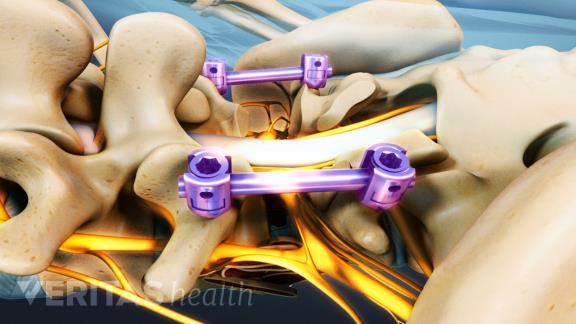
POSTERIOR LUMBAR INTERBODY FUSION
Share

WHAT IS POSTERIOR LUMBAR INTERBODY FUSION?
A Posterior Lumbar Interbody Fusion (PLIF) is a lumbar fusion procedure from the back, or posterior approach. During this procedure, your surgeon will make a midline incision in order to expose the posterior spine elements, such as the spinous process, lamina and facet joint. Bone is removed to create a window to open the spinal canal. This creates access to remove disc material in order to prepare the space for implants to fuse the bones together. Screws and rods are used to stabilize this fusion process.
WHO NEEDS POSTERIOR LUMBAR INTERBODY FUSION?
Your doctor may determine you are a candidate for Posterior Lumbar Interbody Fusion if you have a history of mechanical low back pain. This low back pain may or may be accompanied by leg pain. Other factors may include degenerative disc disease and lumbar instability, Spondylolisthesis, Spinal Stenosis, spinal instability caused by previous surgeries, or pseudoarthrosis. Additional factors include general health, age, activity levels and other life factors.
HOW IS A POSTERIOR LUMBAR INTERBODY FUSION PERFORMED?
 The patient is placed facedown on the surgical table. A three to six inch incision is made in traditional openings, or a minimally invasive approach may be made using very small incisions and a tubular retractor to gain access to the damaged disc.
The patient is placed facedown on the surgical table. A three to six inch incision is made in traditional openings, or a minimally invasive approach may be made using very small incisions and a tubular retractor to gain access to the damaged disc.
To gain access to the damaged disc, all or a portion of the lamina is removed. This exposes the disc for access and removal.
The damaged disc nucleus and annulus is removed, but the disc wall is left mostly intact to help contain the bone graft material.
Bone grafts and/or allograft material (morselized bone) is placed inside the disc space. The bone grafts help restore disc height and relieve pressure on nerves causing pain.
To maintain stability and hold the graft in position, the surgeon may add rods, screws or other surgical constructs, for additional support. Additional bone graft may be added along the sides of the spine.
The allograft material helps your body grow bone around the implants and creates a natural bony bridge that connects the two vertebrae. This solid bridge of bone is called a fusion.
AFTER TREATMENT AND RECOVERY
Your surgeon may place a drainage tube in the wound site. He may also elect to use a back brace to stabilize your spine while it heals. You may be in the hospital three to five days with a standard incision. Minimally invasive approaches typically result in a shorter hospital stay of one to two days.
You may be prescribed medication and physical therapy after sufficient time has passed for the bone graft to occur. Be sure to follow your physician's treatment and recovery plan, and always consult them if you have any questions.
POTENTIAL ADVANTAGES AND DISADVANTAGES
Doing a pure PLIF surgery has the advantage that it can provide anterior fusion of the disc space without having a second incision as would be necessary with an anterior/posterior spine fusion surgery. However, it has some disadvantages:
- Not as much of the disc space can be removed with a posterior approach (from the back).
- An anterior approach (an ALIF, from the front) provides for a much more comprehensive evacuation of the disc space and this leads to increased surface area available for fusion.
- A larger spinal implant can be inserted from an anterior approach, which provides for superior stabilization.
- In cases of spinal deformity (e.g. isthmic spondylolisthesis) a posterior approach alone is more difficult to reduce the deformity.
- There is a small but finite risk that inserting a cage posteriorly will allow it to retro pulse back into the canal and create neural compression.
PLIF surgery has a higher potential for a solid fusion rate than posterolateral fusion rates because the bone is inserted into the anterior portion (front) of the spine. Bone in the anterior portion fuses better because there is more surface area than in the posterolateral gutter, and also because the bone is under compression. Bone in compression heals better because bone responds to stress (Wolff's law), whereas bone under tension (posterolateral fusions) does not see as much stress.
POTENTIAL RISKS AND COMPLICATIONS
The principal risk of a PLIF is that a solid fusion will not be obtained (nonunion), and further back surgery to re-fuse the spine may be necessary. Fusion rates for a PLIF should be as high as 90-95%.
Nonunion rates are higher for patients who have had prior spine surgery, patients who smoke or are obese, patients who have had a multiple level fusion surgery, and for patients who have been treated with radiation for cancer. Not all patients who have a nonunion will need to have another spine fusion procedure. As long as the joint is stable, and the patient's symptoms are better, more back surgery is not necessary.
Other than nonunion, the risks of a spinal fusion surgery include infection or bleeding. These complications are fairly uncommon (approximately 1% to 3% occurrence). In addition, there is a risk of achieving a successful spine fusion, but the patient's pain does not subside.

